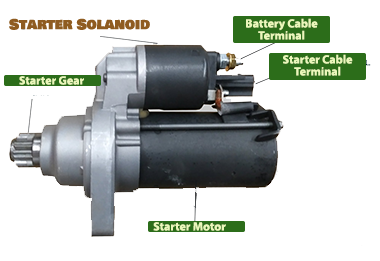
Maintaining a classic car starter is crucial to ensure that the car starts smoothly and efficiently every time. Here are some tips on how to maintain your classic car starter:
![]() Dirt and grime can build up around the starter and cause it to malfunction. So, it's essential to keep the starter clean. Use a soft brush or a rag to wipe the dirt away from the starter. You can also use compressed air to blow out any dirt or debris.
Dirt and grime can build up around the starter and cause it to malfunction. So, it's essential to keep the starter clean. Use a soft brush or a rag to wipe the dirt away from the starter. You can also use compressed air to blow out any dirt or debris.

![]() Check the connections of the starter regularly to ensure they are tight and secure. Loose connections can cause the starter to fail. Use a wrench to tighten any loose connections.
Check the connections of the starter regularly to ensure they are tight and secure. Loose connections can cause the starter to fail. Use a wrench to tighten any loose connections.
![]() The starter has moving parts that require lubrication to function correctly. To lubricate the starter, all that is required is small brush to apply an ample layer of moly grease on the pinion. Use a high-quality lubricant to lubricate the starter.
The starter has moving parts that require lubrication to function correctly. To lubricate the starter, all that is required is small brush to apply an ample layer of moly grease on the pinion. Use a high-quality lubricant to lubricate the starter.
![]() : If any components of the starter are worn or damaged, it's crucial to replace them immediately.
: If any components of the starter are worn or damaged, it's crucial to replace them immediately. Worn components can cause the starter to malfunction and fail.
Worn components can cause the starter to malfunction and fail.
The components that go to make up a starter motor are as follows:

![]() Check rotor arm and the top of the coil with a petrol-wetted rag and inspect them for cracks and burning. Make sure the metal contacts of the cap are not burned or corroded and check that there’s a sprung carbon contact on the inside. Clean and inspect the HT leads.
Check rotor arm and the top of the coil with a petrol-wetted rag and inspect them for cracks and burning. Make sure the metal contacts of the cap are not burned or corroded and check that there’s a sprung carbon contact on the inside. Clean and inspect the HT leads.
![]() On a regukar bases, the king lead on the rotor arm should be removed and held around 5mm from the engine block using insulated pliers. As the engine is cranked, a strong spark should jump from the end of the lead. Now reconnect it and remove a spark plug lead. Push a bolt inside the plug cap and hold it 5mm from the block. The spark should be just as strong as before (though not as frequent).
On a regukar bases, the king lead on the rotor arm should be removed and held around 5mm from the engine block using insulated pliers. As the engine is cranked, a strong spark should jump from the end of the lead. Now reconnect it and remove a spark plug lead. Push a bolt inside the plug cap and hold it 5mm from the block. The spark should be just as strong as before (though not as frequent).
![]() Setting the gap as detailed in the workshop manual
Setting the gap as detailed in the workshop manual
 The process gets underway throught cleaning any waste matter from the outside of the spark electrode. Next, 220-grit sandpaper can be used to gently sand away any build up – using a light touch to avoid damaging the metal. A small file can also be used to clear any obstinate accumulation.
The process gets underway throught cleaning any waste matter from the outside of the spark electrode. Next, 220-grit sandpaper can be used to gently sand away any build up – using a light touch to avoid damaging the metal. A small file can also be used to clear any obstinate accumulation.
 If the clearances are too small or non-existent, vital compression will be lost and the engine won’t start. If the problems persist, check that the valve clearances are correct.
If the clearances are too small or non-existent, vital compression will be lost and the engine won’t start. If the problems persist, check that the valve clearances are correct.
By following these tips, the classic car starter will remain in prime condition, ensuring that the car starts smoothly and efficiently every time.





